
Distilled Demographics: Urbanization
Distilled Demographics,” PRB’s educational video series, highlights key demographic concepts such as fertility, mortality, and migration. Through these short videos, you can learn demography’s real-world application and impact. “These videos not only show that demography can be exciting, but also highlight how population trends and issues affects the well-being of us all,” says Carl Haub, senior demographer at PRB. “Fertility, mortality, and migration—along with other demographic issues—play a major role in determining what kind of opportunities and challenges people face in their communities and countries.”
A few years ago, it was announced that half the world’s population now lives in urban areas. When we think of urbanization, we tend to think of sprawling cities with skyscrapers. However, the definition of “urban” varies greatly from country to country. In this video, PRB senior demographer Carl Haub discusses the global diversity of “urban” areas and the implications of a more urban world.
PRB’s Distilled Demographics video series is underwritten through the generosity of Juanita Tamayo Lott and Robert H. Lott in support of PRB’s Millennial Generation Outreach Program, and in memory of Jorge del Pinal.

What Is a City? What Is Urbanization?
In 2008, the United Nations announced that 50 percent of the world’s population now lives in urban areas, a milestone in demographic history.
News reports on the subject frequently rephrased this development slightly to say that half of the global population now lives in “cities” and illustrated articles with photos of Mumbai, Shanghai, or New York. These cities are what the UN terms “mega-cities,” urban areas of 10 million people or more. The distinct impression was created that a majority of people lived in very large cities. However, only about 5 percent of world population lives in the largest cities or, more properly, metropolitan areas. The fact that over half of the world’s population live in places termed urban is a notable development, to be sure. But, at the same time, it is useful and important to know just how the term “urban” is defined.
In most countries, a large part the urban population actually lives in relatively small towns and villages. The urban population may also be thought of more as nonagricultural than urban in the way those in industrialized countries would naturally tend to perceive it. In its most recent urbanization estimates and projections, the UN Population Division recognized that when urbanization is discussed, “the focus is often on large cities, cities whose populations are larger than many countries.” The table below gives examples of how countries themselves define urban. The great variation in the urban definition and the size of places deemed urban is readily apparent (see table).
Selected Urban Definitions With Population Size and Other Criteria
| Country | Urban Definition |
|---|---|
| Argentina | Populated centers with 2,000 or more |
| Canada | Places of 1,000 or more* |
| China | Cities designated by the State Council and other places with density of 1,500 or more per sq. km.* |
| India | Specified towns with governments and places with 5,000 or more and at least three-fourths of the male labor force not in agriculture* |
| Japan | Cities (shi) with 50,000 or more* |
| Maldives | Male, the capital |
| Mexico | Localities of 2,500 or more |
| New Zealand | Cities, towns, etc. with 1,000 or more |
| Niger | Capital city and department and district capitals |
| Norway | Localities of 200 or more |
| Peru | Populated centers with 100 or more dwellings |
| Senegal | Agglomerations of 10,000 or more |
| United States | Places of 2,500 or more, urbanized areas of 50,000 or more* |
* There are some additional requirements regarding population size, population density, and specified urban characteristics.
Source: United Nations Statistics Division, 2007 Demographic Yearbook: table 6.
The UN projects that the world’s urban population will grow by 1.8 percent per year and by 2.3 percent per year in developing countries from 2007 to 2025.1 Both are rather high rates of growth. In fact, by 2020, the world’s rural population will cease growing altogether and begin to decline.
In part, the world’s urban population will continue to grow simply because towns and villages not considered urban today will grow over time. Equally important, migration to urban areas can be expected to increase as economies grow and the likelihood of earning a higher income in cities increases. Much rural-to-urban migration will take place as a result of hardship, as the rural and landless poor make their way to cities and towns in hopes of any employment. One manifestation of such disparate reasons for migration is the Indian mega-city of Mumbai, which contains many of India’s wealthiest celebrities and business leaders and a relatively comfortable middle class alongside the 54 percent of the population living in officially defined slums.
Statistics on the percentage of the world’s population living in urban areas also hide the nature of places deemed urban. For example, “urban” is an entirely different experience in many areas of Africa from what it might be in a developed country. In developing countries, many urban residents live in settlements with little access by road, limited availability of electricity, and little or no access to clean water or basic sanitation. The classification “urban” does not automatically mean that the population has become literate or lost its traditional rural values and social customs. In developed countries, the rural population, on the other hand, often has the same access to amenities and services as urban areas and is almost indistinguishable from the urban other than by location or size of place. Excellent road connections, communications, cable TV and Internet, and access to many of the same services and shopping facilities have rendered the urban-rural difference less relevant in developed countries than it once was.
As with any statistical definition, it is always wise to look “under the hood.” The world is rapidly becoming more urban; the number of mega-cities in the developing world will grow over the next few decades as cities such as Kinshasa, Lagos, and Jakarta are projected to grow to well over 10 million people by 2025. However, “urban” is not a homogenous term and most of the world’s urban population will continue to live in small towns and areas that are a far cry from large cities with skyscrapers and bustling traffic.
Reference
- United Nations Population Division, World Urbanization Prospects: The 2007 Revision Population Database, accessed online at http://esa.un.org/unup/index.asp, on Sept. 28, 2009.

World Population Highlights 2007: Urbanization
Date
August 16, 2007
Author
PRB
(September 2007) The world is on the verge of a shift: from predominantly rural to mainly urban. In 2008, more than half the world’s people will live in urban areas.
By 2030, urban dwellers will make up roughly 60 percent of the world’s population.
The world’s regions differ greatly in their levels of urbanization. In North America, Europe, and Latin America and the Caribbean, more than 70 percent of the population is already urban; but in Africa and Asia, less than 40 percent of the population is urban.
Just 5 Percent of the World’s Population Lives in Urban Areas of 10 Million of More.
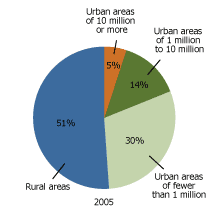
Source: United Nations, World Population Prospects: The 2006 Revision (2007).
Where Will Populations Grow?
Contrary to popular belief, the bulk of urban population growth is likely to occur in smaller cities and towns of less than 500,000. Globally, all future population growth will take place in cities, especially in Asia, Africa, and Latin America. In Asia and Africa, this growth will signal a shift from rural to urban growth, changing a millennia-long trend.
Between 2000 and 2030, the urban population in Africa and Asia is set to double. Asia’s urban population will grow from 1.4 billion to 2.6 billion. Africa’s will surge to more than twice its size, from 294 million to 742 million. Latin America and the Caribbean will see its urban population rise from 394 million to 609 million. By 2030, 79 percent of the world’s urban dwellers will live in the developing world’s towns and cities. And Africa and Asia will account for almost seven in every 10 urban inhabitants globally.
Poor people will make up a large part of future urban growth. Most urban growth is due to natural increase (more births than deaths) rather than migration.
By 2030, Nearly Two-Thirds of the World’s Population Will Live in Urban Areas.
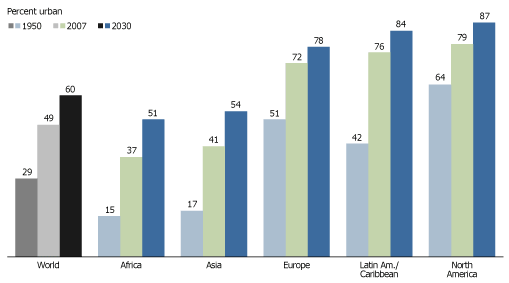
Source: United Nations, World Urbanization Prospects: The 2005 Revision (2006) and Carl Haub, 2007 World Population Data Sheet.
Largest Urban Areas
The largest cities in the world are slowly growing in size, and increasingly they are located in less developed regions. In 1950, the three largest cities were New York-Newark (12.3 million), Tokyo (11.3 million), and London (8.4 million). By 2015, the UN projects that Mumbai and Mexico City will have replaced London and New York-Newark in the top three: Tokyo at 35.5 million, Mumbai at 21.9 million, and Mexico City at 21.6 million.
While slightly more than 9 percent of urban dwellers live in cities of 10 million or more people, about 62 percent live in cities of 1 million or fewer. About 52 percent of urbanites overall live in cities of fewer than 500,000 residents.
Not all cities in the world would feel like a city to outsiders. While high-rise living, skyscrapers, and modern transportation and sanitary facilities may be common in cities in the developed world, other urban areas are far different. In the slums of Lagos, Nigeria, dirt paths are the main way to get around. In India, 31 percent of urban households do not have a bathroom facility in the house.
How Does Urbanization Affect the Environment?
Urban people change their environment through their consumption of food, energy, water, and land. In turn, the polluted urban environment affects the health and quality of life of the urban population.
People who live in urban areas have very different consumption patterns than residents of rural areas. For example, urban populations consume much more food, energy, and durable goods than rural populations. In China during the 1970s, the urban populations consumed more than twice as much pork as the rural populations who were raising pigs.
By extension, the energy consumption for electricity, transportation, cooking, and heating is much higher in urban areas than in rural villages. For example, urban populations have many more cars than rural populations per capita.
The urbanization of the world’s populations will increase aggregate energy use. And the increased consumption of energy is likely to affect the environment.
Urban consumption of energy creates heat islands that can change local weather patterns and weather downwind from the heat islands. The heat island phenomenon is created as cities radiate less heat back into the atmosphere than rural areas, making cities warmer than rural areas. These heat islands trap atmospheric pollutants. Cloudiness and fog occur more often. Precipitation is 5 percent to 10 percent higher in cities, and thunderstorms and hailstorms are much more frequent.
Urbanization also affects environments beyond the city. Regions downwind from large industrial complexes see increases in the amount of precipitation, air pollution, and the number of days with thunderstorms. Urban areas also affect water runoff patterns. Not only do urban areas generate more rain, they reduce the infiltration of water and lower the water tables. This means that runoff occurs more quickly with greater peak flows. Flood volumes increase, as do floods and water pollution downstream.
Many of the effects of urban areas on the environment are not necessarily linear. Bigger cities do not always lead to more environmental problems and small urban areas can cause large problems.
Density is potentially beneficial. With world population growing by about 82 million a year, demographic concentration makes sustainability more likely. Global urban expansion takes less land than land lost every year to agriculture, forestry, and grazing, or to erosion and salinization.
Case In Point
How do you define urban? It depends. Definitions differ from one country or area to the next. For Peru, populated centers of 100 or more dwellings are considered urban. In contrast, it takes a lot more for an area to be designated a city in Japan, where cities must be home to 50,000 or more inhabitants with 60 percent or more of the houses located in the main built-up areas and 60 percent or more of the population (including their dependents) engaged in manufacturing, trade, or other urban kinds of business.
In Mongolia, the capital and district centers are the cities. In South Africa, places where some form of local authority exists count as cities.
In other places, urban is defined by available services. By 1970, Panama’s urban areas included localities of 1,500 or more inhabitants, and had such urban characteristics as streets, water supply systems, sewage systems, and electricity.
Sometimes what helps distinguish urban from rural areas is the nature of the population, particularly the extent to which it is nonagricultural. In Botswana, an agglomeration of 5,000 or more inhabitants where 75 percent of the economic activity is nonagricultural is classified as urban.
Sources
Carl Haub, 2007 World Population Data Sheet (Washington, DC: Population Reference Bureau, 2007).
George Martine, The State of World Population 2007: Unleashing the Potential of Urban Growth (New York: United Nations, 2007).
Office of the Registrar General, India; “Census of India 2001: Table S00-017: Distribution of Households by Availability of Bathroom, Type of Latrine Within the House and Type of Drainage Connectivity for Waste Water Outlet,” accessed online at www.censusindia.net, on July 6, 2007.
Barbara Boyle Torrey, “Urbanization: An Environmental Force to Be Reckoned With,” accessed online at www.prb.org, on June 26, 2007.
United Nations, World Urbanization Prospects: The 2005 Revision (New York: United Nations, 2006).
United Nations, 2003 Demographic Yearbook (New York: United Nations, 2006).

Urban Population to Become the New Majority Worldwide
(July 2007) For the first time, more than half the world’s population will be living in cities and towns by next year, according to the State of World Population 2007 report from the United Nations. Less developed regions will hit the half-way point later, but likely before 2020. The urban percentage of the world’s population is projected to reach 60 percent by 2030 (see figure). The urban share is likely to rise from 75 percent to 81 percent in more developed countries between 2007 and 2030, and from 44 percent to 56 percent in less developed countries.
Percent Urban, 2007, 2015, and 2030
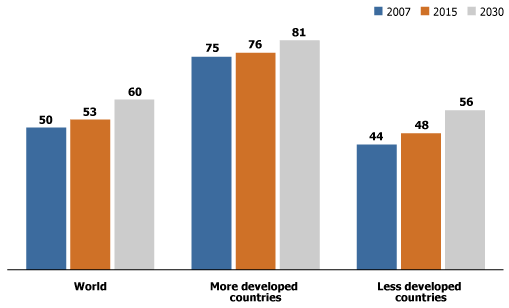
Source: United Nations Population Fund, State of World Population 2007; and United Nations Population Division, World Urbanization Prospects: The 2005 Revision (2006).
The 3.3 billion global urban population is expected to grow to 4.9 billion by 2030.
Growth in smaller cities and towns is expected to account for most of the urban population increase. Urbanized areas in Africa and Asia are forecast to grow most rapidly, doubling in population between 2000 and 2030, according to the UN Population Fund, which released the report.
Rural populations, meanwhile, are forecast to decrease by 28 million between 2005 and 2030, because of mortality among the older rural residents and migration of many younger residents to urban areas.
References
United Nations Population Division, World Urbanization Prospects: The 2005 Revision (2006), accessed online at www.un.org, on July 16, 20007.
United Nations Population Fund, State of World Population 2007: Unleashing the Potential of Urban Growth, accessed online at www.unfpa.org, on July 16, 2007.

The Social and Economic Isolation of Urban African Americans
(October 2005) Hurricane Katrina’s devastation in late August of much of the northern Gulf Coast followed by the slow institutional response to the crisis exposed the impoverishment and disempowerment of many African Americans. The media images of a predominantly African American population left to fend for itself in New Orleans demonstrated to many surprised observers the enduring color line in that city.
But striking disparities between urban blacks and whites in the United States are hardly unique to New Orleans. In large cities across the nation, African Americans are much more likely than whites to be living in communities that are geographically and economically isolated from the economic opportunities, services, and institutions that families need to succeed. These disparities have left African Americans disproportionately vulnerable to the next urban calamity, be it from terrorism or another natural disaster.
No Job, No Car, No Phone: An Entrapping Lack of Basic Resources
Of the 15 U.S. metropolitan areas with the most African Americans in absolute numbers in 2000, New Orleans had the highest black poverty rate, at 33 percent.1 But racial differences in poverty were stark in each of these metropolitan areas except New York. In Chicago, Newark, Memphis, and St. Louis, African Americans were about five times more likely than whites to be impoverished.
Higher poverty rates for African Americans are also linked to lower levels of education and employment—key elements in attaining economic well-being. In 2000, blacks in these large cities were also far less likely to own a car or a phone, and they were on average younger and more often female than their white counterparts.
Education. Nationwide, about 75 percent of African Americans age 25 or older do not have a college diploma, and 80 percent lacked college degrees in all but two of the 15 largest U.S. metropolitan areas—Washington, D.C. and Atlanta. Whites were more than twice as likely to be college graduates in a dozen of these cities, with the largest disparities (2.5 times) in Memphis, New York City, and Philadelphia.
Employment. One-third to one-half of African American males age 16 or older in the largest 15 U.S. cities were not employed in 2000. Some of these were “discouraged” workers who have left the labor force after numerous unsuccessful attempts to secure a job. In Chicago, Detroit, Philadelphia, Los Angeles-Long Beach, New Orleans, and St. Louis, only about one-half of African American males were employed (see table). Blacks in these cities were three-quarters as likely as whites to have a job.
Cars and phones. African Americans are also much more likely than whites to lack basic amenities—such as an automobile or a telephone—that facilitate economic mobility and that many Americans take for granted (see table). In each of the 15 largest U.S. metropolitan areas except New York (where many residents do not have personal transportation), African Americans were about three times as likely as whites to not have an automobile in 2000. In a dozen of these areas, African Americans were at least three times more likely than whites to not have a telephone, with the racial gap in telephone ownership being eight-fold in Newark and Chicago.
Age and sex ratio. African Americans in major U.S. cities are often younger and more likely to be female than their white urban counterparts. Sex ratios (the number of males per 100 females) as of 2000 were approximately 95 or higher among whites in 11 of the 15 largest metropolitan areas, while they were about 85 or lower among African Americans in 10 of the 15 localities. The relative absence of African American males in U.S. cities reflects their high mortality and incarceration rates—factors that weigh heavily in their social and economic entrapment.
Selected Demographic and Socioeconomic Characteristics Among African Americans and Whites in Selected U.S. Metropolitan Areas, 2000
|
Metropolitan area
|
Percent
civilian males 16+ employed |
Percent
no automobile |
Percent
no phone |
|||
|---|---|---|---|---|---|---|
|
Afr. Amer.
|
White
|
Afr. Amer.
|
White
|
Afr. Amer.
|
White
|
|
| Baltimore |
54.4
|
73.2
|
31.4
|
7.8
|
4.7
|
0.9
|
| Chicago |
50.2
|
74.0
|
29.4
|
9.4
|
7.2
|
0.9
|
| Detroit |
51.4
|
71.7
|
19.5
|
5.9
|
6.3
|
1.5
|
| Los Angeles-Long Beach |
50.9
|
67.4
|
20.1
|
7.8
|
2.8
|
0.8
|
| Newark |
54.2
|
72.4
|
32.3
|
7.4
|
5.7
|
0.7
|
| New Orleans |
50.0
|
68.6
|
29.6
|
7.7
|
5.9
|
1.8
|
| Philadelphia |
50.7
|
70.6
|
36.6
|
10.0
|
3.5
|
0.6
|
| St. Louis |
52.0
|
72.3
|
22.9
|
5.9
|
4.8
|
1.3
|
Source: Census 2000 5% Public Use Microdata Sample (PUMS).
The Extreme Isolation of the African American Poor
African American Percentage of Total Population and Poverty Population in Selected U.S. Cities, 2000
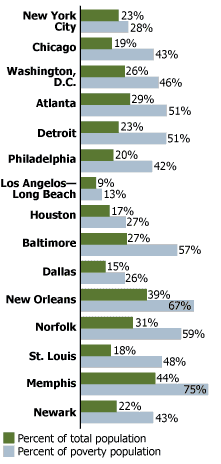
Source: Census 2000 5% Public Use Microdata Sample (PUMS).
Not surprising, poor urban African Americans exhibit even greater levels of social and economic isolation in the United States than the general black population, even when compared with poor urban whites:
- In all but two of the 15 largest U.S. metropolitan areas as of 2000, the presence of African Americans in the poverty population was 1.5 times greater than their representation in the cities’ overall populations (see figure). In six of the cities—St. Louis, Chicago, Detroit, Philadelphia, Baltimore, and Newark—African Americans were twice as likely to be part of the poverty population relative to their percentage of the total population of these areas.
- Vulnerable populations such as African American children and the elderly were similarly overrepresented among the poor in major U.S. cities in 2000. In all but two of the 15 largest U.S. metro areas, the percentage of African American elderly who were poor was twice their percentage of the city’s total elderly population. The faces behind these percentages were made vivid by the stories and numbers of elderly blacks trapped in houses and nursing homes as the floodwaters from Katrina rose in New Orleans.
- In all but two of the 15 largest African American metro areas, at least 40 percent of poor blacks did not own a car in 2000, with upwards of 60 percent lacking a vehicle in New York City, Baltimore, Philadelphia, and Newark. And poor blacks were often twice as likely as poor whites to lack a telephone in these cities.
- White poor people were more than three times as likely as the African American poor to be college graduates in every city studied except Atlanta. Only 25 percent of the cities’ poor African American males on average had a job.
Reducing the Risk of Future Disasters for Urban African Americans
African Americans not only have the highest levels of poverty in the country, but they are also the group that is most residentially segregated from and least likely to intermarry with whites. Surveys also continue to reveal that many nonblack Americans express high levels of social distance (the degree to which people desire close or remote social relations with members of other groups) from African Americans.2 Given their limited social and economic resources along with their geographic isolation, poor urban African Americans—especially children and the elderly—are disproportionately vulnerable to being left behind during a crisis situation.
What measures need to be taken to improve the social and economic position of African Americans and to avoid future disasters such as the recent one in New Orleans?
- Skills-development, employment, and health-maintenance programs need to be targeted to and strengthened for African Americans.
- Funding and access to education—including Head Start—should be increased for African Americans in order to bolster their social and economic well-being and competitiveness in the labor market.
- Additional policies, resources, and investment are needed to promote the development and relocation of businesses (and thus jobs) to African American urban neighborhoods.
- Government agencies responsible for responding to natural disasters need to factor into their planning the economic and geographic isolation of African Americans—especially the African American urban poor.
Aggressive actions are needed to erase the marginalization of African Americans that Hurricane Katrina exposed. The failure to take such actions will have enormous economic and social costs—not just for African-Americans, but for a society living with a disjuncture between its ideals and the reality of continued stratification along the color line.3
Rogelio Saenz is a professor of sociology at Texas A&M University and author of “Latinos and the Changing Face of America,” in The American People: Census 2000, ed. Reynolds Farley and John Haaga (New York: The Russell Sage Foundation, 2005).nbsp;
References
- Data from the Census 2000 5% Public Use Microdata Sample (PUMS) are used to examine the standing of African Americans (relative to whites) in the 15 most populous African American Primary Metropolitan Statistical Areas (PMSAs) and Metropolitan Statistical Areas (MSAs). The statistics are based on the populations of the central cities and the suburbs comprising each PMSA and MSA.
- Tom Smith, Intergroup Relations in a Diverse America: Data from the 2000 General Social Survey (New York: The American Jewish Community, 2001).
- I acknowledge the helpful comments of Karen Manges Douglas and David Geronimo Embrick on an earlier draft of this report.

Minority Suburbanization
Date
May 1, 2002
Author
PRB
(May 2002) The suburbs of America’s cities are often seen as the bastions of white, middle-class families. But increasingly, America’s suburbs reflect the growing diversity in the United States as a whole.
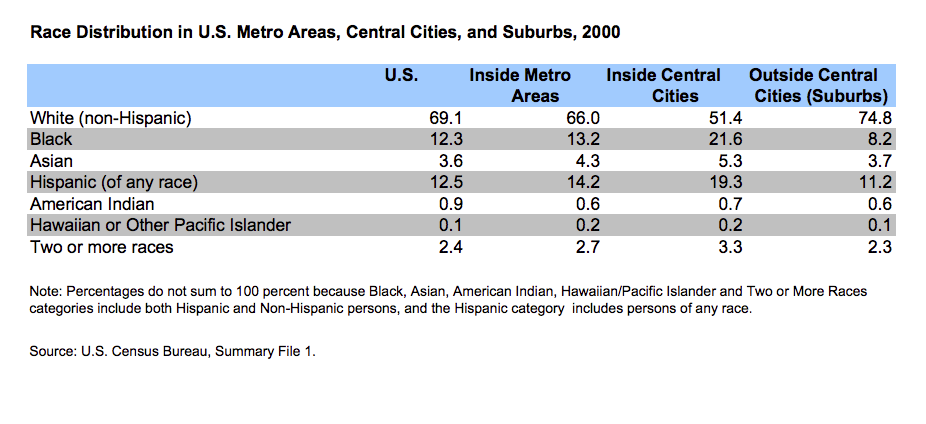
In the nation’s largest metropolitan areas (those with populations exceeding 500,000), minorities accounted for 27 percent of the suburban populations in 2000, compared with 19 percent in 1990. The rapid increase in minority suburban populations was concentrated in the so-called “melting-pot metros” — New York, Los Angeles, Chicago, San Francisco, Miami, and other immigrant gateways. Minority population growth in these areas is driven by increases in the Asian and Hispanic populations, since the majority of blacks living in suburban areas still tend to be in the largely black-white metro areas in the South. Many of the metro areas experiencing marked increases in their minority suburban populations saw decreases in their white suburban populations.
There was substantial growth in the number of minorities in the West and Southwest, areas with relatively high levels of international immigration. In these metropolitan areas, minority population growth accounted for the majority of suburban population gains.
Despite the minority population increases in suburban areas, minorities still account for a greater share of the population in central cities than in the suburbs. In 2000, Hispanics accounted for 11 percent of the U.S. population in the suburbs and 19 percent of the population in central cities. Blacks made up 8 percent of the suburban population, and 22 percent of the central city population. Non-Hispanic whites, on the other hand, accounted for about three-fourths of the suburban population in 2000, but just over half of the population in central cities.
Source: Frey, William H., “Melting Pot Suburbs: A Census 2000 Study of Suburban Diversity,” Washington, DC: The Brookings Institution, Census 2000 Series, 2001.

Urbanization Takes on New Dimensions in Asia's Population Giants
(This is an expanded version of an article that appeared in the October 2001 issue of Population Today.)
(October 2001) For the first time, more half of the world’s population will be living in urban areas by the end of this decade. In 1999, 47 percent of the world’s population (2.9 billion people) lived in urban places.1 By 2030, the UN projects that proportion will reach 60 percent, totaling 4.9 billion people. Roughly 95 percent of this massive urban growth will occur in less developed countries.2
More than 60 percent of the increase in the world’s urban population over the next three decades will occur in Asia, particularly in China and India, but also in Pakistan, Bangladesh, the Philippines, and Vietnam. Asia will have a lower overall urbanization rate in 2030 (53 percent) than any other region — Africa will be slightly higher at 55 percent, while Latin America is projected to reach 83 percent — but Asia’s total urban population will exceed 2.6 billion in 2030, compared with 604 million in Latin America and 766 million in Africa (see figure).3
Urban Population by Region: 2000 and 2030
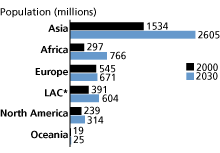
*LAC = Latin America and the Caribbean.
Source: UN, World Urbanization Prospects: The 1999 Revision, 2000.
In Asia and elsewhere, the prospect of urbanization on such a massive scale fuels concerns that the world may not be able to sustain such large urban populations. For some, cities are seen as potential disasters. The growing concentration of people poses a fundamental challenge to the provision of economic opportunity, the development of adequate infrastructure and liveable housing, and the maintenance of healthy environments. In poorer cities, a significant proportion of the population is often forced to live in ill-serviced housing in areas highly vulnerable to natural disasters such as flooding or landslides.
But there are also reasons for optimism. The historic association between economic development and urbanization is well established. Cities are crucial environments and institutional assemblages for economic growth. Current research indicates that even in less developed countries cities experience lower rates of natural population increase than rural areas, average household income is higher, and educational levels are well above those in rural areas. Thus cities can also be seen as places of opportunity in which the major need is effective management and provision of services, creation of economic opportunity, and the provision of safe and healthy environments.
The Challenges of Asia’s Urbanization
To some extent, the challenges of urbanization are the same everywhere. These include enhancing economic opportunities for urban populations, improving transportation infrastructure and housing, providing social services, maintaining a liveable environment, and developing effective systems of governance and management. It is therefore possible to argue that there is nothing distinctive about the challenges posed by Asian urbanization.
Upon closer inspection, however, the process of urbanization in Asia has several distinctive features, a number of which stem from the massive size of the region’s population:
- Dominance of the population giants. Unlike any other region, Asia has five less developed countries with more than 100 million people — China, India, Bangladesh, Pakistan, and Indonesia. These countries made up 75 percent of the Asian population as of mid-2001. In 2030, they will be joined by Iran, the Philippines, and Vietnam, and together these countries will constitute 81 percent of Asia’s population. The combined urban population of these 8 countries will grow by more than 1 billion people in the same period, making up roughly four-fifths of the total urban increment in Asia. The dominance of the population giants in all-Asia averages is important to keep in mind since it can obscure developments in the region’s numerous smaller countries.
- Immense urban increments. The sheer size of some Asian populations forces governments to cope with a large volume of urban increase in a very short period of time. The urban populations of both China and India, for example, will grow by more than 340 million by 2030. This creates tremendous challenges in the provision of infrastructure, environmental management, and employment.
Even a small country such as Laos (5.3 million in 2000), one of the poorest countries in the world, will add 3.2 million to its urban population while it moves to a level of only 43 percent urbanized in 2030. This will be more than 60 percent of the country’s total population increase in that period. Given its very low national income and the continuing high proportion of people in rural areas, it will be very difficult to give strategic priority to urban development, even in the capital city of Vientiane. - The prominence of megacities. By 2015, 16 of the world’s 24 megacities (cities with more than 10 million people) will be located in Asia, according to the UN’s World Urbanization Prospects: The 1999 Revision. Most of these megacities will be located in the population giants. While most urbanites both in Asia and elsewhere will continue to live in smaller towns and cities, the urban hierarchy of Asia will be dominated by the emergence of these larger cities.4 Urban development will often stretch in corridors between the main city core and secondary cities, much like the megalopolis of the eastern United States.
- Uneven globalization. For the past two decades, Asia has surpassed the rest of the less developed world in terms of integration into the global economy, creating greater opportunities for urban development. This development has proceeded unevenly, however, and a two-tier urban system is likely to emerge in Asia as a result (see table). Some urban areas will be increasingly integrated into the global economy and become more international in character. These towns and cities — such as Seoul, Singapore, Taipei, and Shanghai — will have to manage the challenges and opportunities that come with rapid economic growth and change. On the other hand, there will also be cities with more domestically oriented economies that develop more slowly. These urban places will face greater challenges in terms of poverty and creating opportunities for economic growth. Cities such as Dhaka, Phnom Penh, and Vientiane exemplify this group.
A Tale of Two Cities: Seoul and Dhaka
The two-tier structure of Asian urbanization described above can be illustrated by comparing two of the region’s largest cities, Seoul and Dhaka.5
The Seoul Metropolitan Region: Planning with Growth
The city of Seoul, with a population of 10.3 million in 1998, forms part of South Korea’s capital region, which includes the city of Inchon as well as Kyonggi province. Including Seoul, this region had a population of 20.7 million in 1998. As the capital city, Seoul has been at the center of South Korea’s remarkable economic transformation over the last four decades. In 1961, the national population stood at 24.6 million, per capita income was US$83, and primary production made up 37 percent of GNP.6 By 1990, the population had almost doubled to 46 million and the contribution of the primary sector to GNP had fallen to 10 percent. The national level of urbanization had risen from 28 to 75 percent. Much of this societal change was due to the growth of industry, which increased its share of GDP from 20 percent in 1960 to 44 percent in 1990.
In the 1960s, much of South Korea’s industrial growth was focused on greater Seoul, which by 1970 had 52 percent of the country’s industrial workers. The major contributor to this growth was rural-urban migration, which accounted for 50 percent of the country’s urban increment in the 1960s. This very rapid growth of Seoul’s population placed pressure on the city’s infrastructure, leading to marked growth in squatter settlements, increasing traffic congestion, and growing air pollution. This led the government to adopt a national decentralization strategy in the 1970s that attempted to divert industry to other areas of the country. New industrial complexes were established in the southeast part of the country. In the 1980s, continuing efforts were made to decentralize economic activity, and ambitious investments in Seoul’s infrastructure and public and quasi-public housing were made before the 1988 Seoul Olympics.
In the late 1980s and 1990s, Seoul continued to lose industrial employment and increase its employment in the service sector. For example, 44 of South Korea’s top 50 firms by sales have their headquarters in Seoul. The upshot of this trend has been declining population in the Seoul area. In addition, due in part to the city’s success in hosting the Olympics, Seoul has embarked on an ambitious effort to become a global city with the addition of a new airport and greatly enlarged subway system. Today, Seoul ranks number 13 out of 44 in the Asia Urban Quality of Life Index prepared annually by Asiaweek magazine. In short, while Seoul still has many problems, the government has responded very successfully to the urban challenges that will face many other Asian countries over the next thirty years.
Dhaka, Bangladesh: Ongoing Urban Poverty
Dhaka’s population of 6.5 million is crowded into 360 square kilometers, creating one of the highest urban densities in the world. The city proper also forms part of the Capital Development Authority that administers an area of 1530 square kilometres, an area that is home to an estimated 10 million people. Unlike South Korea, Bangladesh has not experienced rapid economic change, and agriculture remains the major component of GDP and the main source of employment. While general economic conditions have improved somewhat over the last twenty years, Bangladesh is still a very poor country. In 2001, gross national income (adjusted for purchasing power parity) stood at US$1,530 per capita — far below the average for Asia as a whole (US$3,930) and even below the average for Africa (US$1,790). And while estimates vary, most analysts place the current incidence of poverty in both rural and urban areas at between one-third to one-half of the population.
Dhaka’s rate of population growth has declined slightly over the past three decades, but it still remains among the highest in Asia (4.2 percent annually). The continuing growth reflects ongoing migration from rural areas to the Dhaka urban region. Such growth accounted for roughly 60 percent of the city’s growth in the 1960s and 1970s, but more recently the city’s population has also grown as a result of the expansion of its administrative boundaries, a process that added 1 million people to the city in the 1980s. In contrast, the rate of natural increase (i.e., growth due to births exceeding deaths) in the city has been falling, as is the case in most other Asian cities.
Dhaka’s growth has not been associated with an expansion of productive employment opportunities in relatively high wage areas. Instead, there has been growing employment in the low productivity, low-income sector, such as petty retailing or rickshaw driving. This has meant that the number of people defined as poor in the city grew by almost 2 million between 1980 and 2001. While in recent years the introduction of textile export industries and remittances from international labor have begun to diversify the economic base of the city, it still remains desperately poor (see table).
Asia’s Two Urban Tiers: Seoul vs. Dhaka, 1998
| Seoul | Dhaka | |
|---|---|---|
| Resident population (millions) | 10.3 | 6.5 |
| Annual rate of increase | -0.70% | 4.20% |
| City product (per capita)* | US$30,000 | US$2,801 |
| Under-5 child mortality rate | 0.60% | 9.30% |
| Adult literacy rate | 100% | 60% |
| Households with telephone access | 95% | 9% |
Dhaka offers a very different statistical picture from Seoul’s. The population is growing quite rapidly due to rural-urban migration, urban boundary extension, and to a declining extent, natural increase. This growth rate is further enhanced by increasing life expectancy and population momentum (a high proportion of the population is under the age of 15), although infant mortality remains high. Given the large numbers of people living in the city and the generally low incomes, current investment in social services is inadequate. The number of children per classroom and the number of people per hospital bed are among the highest ratios of the cities in the Asia Development Bank database. Dhaka also has a weak physical infrastructure, with a transportation system that is dominated by pedestrians and rickshaw use.
Dhaka has a very uneven mix of physical service provision. Only one-quarter of the city’s population is connected to the piped sewerage system, and only two-thirds of the households are connected to water. A majority of the unconnected households use open latrines. The result is that Dhaka has one of the highest rates of death from infectious disease of any city in Asia. Finally, Dhaka is located on a flood plain and is vulnerable to flooding and other environmental disasters. In short, Dhaka is a city very much on the edge of sustainability. National policies that promote economic growth and urban governance that provides adequate services will be crucial in creating a sustainable, liveable, and healthy city in the future.
Sustainable Development and Cities
The preceding examples offer two extremes of the types of policy challenges faced by the emerging megalopolises of Asia. In cities that are rapidly developing — like Seoul — many of the environmental, transportation, and liveability issues are being addressed. The central policy issues in such cities stem principally from managing growth and mitigating the adverse side effects of economic expansion, particularly in the environmental sphere. At the same time, it should still be stressed that there are still sizeable numbers of poor residents who need help in such cities.
In contrast, the health and livelihood of residents of low-income cities such as Dhaka are undermined by fragile social infrastructures, lack of opportunity, and a marked vulnerability to disease and environmental disaster. In these cases, the major needs are to create a city in which basic needs can be satisfied and opportunity created. Economic, educational, environmental, and health policies have to be directed to the alleviation of these problems.
The urban transition now underway in Asia involves a volume of population much larger than any other region in the world and is taking place on a scale unprecedented in human history. In light of these facts, there are numerous policy implications that need to be considered, all of which involve improving the effectiveness of urban management. The development of effective policies should include the following:
- Creating effective urban databases that enable ongoing monitoring and assessment of city performance.
- Re-evaluating the relationships between national and city governments as urbanization proceeds. For example, decentralization programmes introduced in the Philippines in 1992 have led to fiscal control being transferred to local governments and created many successful local initiatives.
- Providing more low-income housing units, improved transportation systems, clean water and sanitation, and social services.
- Encouraging the participation of civil society in urban governance. For example, the creation of an adequate infrastructure for the cities of Asia will require the investment of trillions of dollars over the next twenty years, a portion of which will have to come from the private sector. To be effective, this process needs input not only from the private sector and local urban governments but also from citizens groups working at the street level as well as national governments and international aid agencies.
- Developing and enforcing environmental standards. This, too, can involve civil society: One important aspect of urbanization in Asia today is the emergence of community-based organizations in poor areas that develop effective local responses to environmental degradation. These organizations are often supported by networks of NGOs that extend their practices to other cities. City governments must learn to work with such groups.
This is a demanding set of challenges, and for many it seems daunting. In Asia, ad hoc approaches will not lead to the development of sustainable and liveable cities. The first steps to cope with the challenges of Asian urbanization are to recognize that urbanization is an integral part of development and give strategic priority to policies for the urban sector.
Terry McGee is a professor of geography at the University of British Columbia, Vancouver, Canada.
References
- Unless otherwise noted, all urban population estimates and projections in this article may be attributed to the UN Population Division’s World Urbanization Prospects: The 1999 Revision (Geneva: UNFPA, 2000).
- There is no general agreement among governments or indeed urban experts on how to define urban settlements. Most governments define urban settlements in one of four ways. First, it can be defined on the basis of threshold size (for example, all communities with at least 2,000 residents). Second, urban spaces may be designated according to size thresholds combined with other criteria such as density. Third, administrative definitions may be used. Fourth, they can be defined as settlements listed in the national census as urban places. This definitional confusion is further compounded by wide variation in the manner in which urban boundaries are delimited. For example, some countries limit urban definitions to administrative boundaries while others extend boundaries outward to include contiguous peri-urban areas of settlement. Such variation makes international comparisons of the urbanization process extremely difficult. For more on global urbanization prospects, read PRB’s Population Bulletin “An Urbanizing World” by Martin Brockerhoff.
- The definition of Asia is highly problematic. In this analysis, the United Nations Population Division definition is used. It includes the area conventionally described as Asia including South Asia, East Asia, and Southeast Asia. But it also includes the Middle East and Central Asia, areas that are not always included in definitions of Asia. Note that this definition does not include Russia, which is included in Europe.
- Despite the rapidly increasing number of megacities around the world — from 3 in 1970 to 24 projected for 2015 — most of the world’s urban population lives in much smaller towns and cities. In 2000, 50 percent of the world’s urban population lived in cities with fewer than 500,000 people. Twenty-five percent lived in cities with between 1 million and 5 million people, while only 9 percent lived in megacities. By 2015, the percentage living in cities of less than 500,000 is expected to fall to 48 percent, while the proportion in megacities is expected to rise slightly to approach 10 percent.
- The urban population figures used in the following section are based on Asian Development Bank (ADB) data from 1998. These data are available on the ADB’s “Cities Data Book” website www.citiesdatabook.org.
- Primary production refers to production, harvesting, and extraction of primary resources such as food, wood, metals, and oil.

The Urban Demographic Revolution
Date
September 1, 2000
Author
PRB
Focus Area
(September 2000) A report commissioned by the German government and released July 4 at the Global Conference on the Urban Future presents an upbeat view of the growth of cities in the 21st century. One reason the report gives for optimism is the “real prospect that population growth, the source of so many problems, will soon slow down … producing a much more steady state.”
Steady there, optimists. Growth rates of megacities — urban agglomerations of 10 million or more residents — have declined sharply, but this is misleading because these cities still have to absorb enormous population increments in the next 20 years; they face daunting challenges of management and governance to sustain health, well-being, and the environment.
The most credible estimates and projections of city size and growth come from the United Nations. These are still based on limited data and are subject to imprecision; projections in particular must be interpreted with caution. Even with a cautious interpretation, however, the picture that emerges from UN data is one of megacity growth, not decline.
Since 1980, the number of megacities in less developed regions has increased from three to 15. More significant demographically, these cities have generally been growing steadily in absolute terms, even as their rates of population growth have dropped in response to national reductions in fertility and to economic downturns that have deterred migration from rural areas.
Megacity Growth: Yesterday and Today
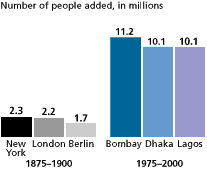
Source: Tertius Chandler, Four Thousand Years of Urban Growth (1987); UN, World Urbanization Prospects: The 1999 Revision (2000).
Cairo exemplifies this pattern. The city’s average annual rate of growth declined from 3.7 percent for the 25-year period 1950 to 1975, to 2.2 percent for 1975 to 2000. But Cairo’s total population grew by 3.7 million people between 1950 and 1975 — from 2.4 million to 6.1 million — and by 4.5 million residents from 1975 to 2000, to over 10 million today.
There is debate about whether some of the world’s poorest megacities, such as Dhaka and Lagos, can effectively absorb the millions of additional residents anticipated in the near future (according to the UN, 9 million more for Dhaka and 10 million more for Lagos by 2015). Alarmists point to the plight of poor residents of Chicago, London, Manchester, New York, and other cities of now-industrialized countries during the era of these cities’ most rapid growth, 1875 to 1900. Although such cities experienced economic progress, they also tended to have higher mortality than rural areas, because of occupational hazards and infectious diseases associated with high population density and poor water and sanitation infrastructure.
The Dickensian conditions of that earlier time — child labor, dilapidated housing, crime, and class tension — are also observed in megacities of poor countries today but on a much larger scale. And they are often accompanied by high levels of pollution and fatalities from motor vehicles, illicit drug use, and widespread sexually transmitted infections such as HIV/AIDS. The greater magnitude of problems in megacities today is suggested by their rapid growth to enormous sizes.
There are also environmental concerns. Modern urban systems require large amounts of energy, and consequent emissions of carbon dioxide and nitrogen oxides from fossil fuel combustion trap excess heat and lead to climate change, rising sea levels, and changes in vegetation.
On the other side of the debate are those who point to the benefits that megacities in developing regions could enjoy in the future. Many economists argue that cities have always been the engines of national economic growth, and that they achieve megacity size only because they are economically efficient for their countries. As international capital becomes more mobile with globalization, large pools of relatively low-skilled labor can attract foreign investment that leads to job opportunities in manufacturing and industry. The growth of Internet technology enables city governments to inexpensively share information regarding effective approaches to poverty alleviation, waste management, affordable housing, and other critical issues of giant cities.
Anthropologists have shown that the urban poor living in slums, shantytowns, and urban fringe areas of megacities are not marginal residents suffering social malaise, but industrious and resourceful people attempting to better their lives. Community mobilization and grass-roots initiatives organized and led by poor constituents have made hundreds of city neighborhoods more livable and could increase the productivity of labor in megacities if applied widely.
Regardless of how megacities are perceived, urban scholars, demographers, and decisionmakers have reached consensus on two issues regarding their treatment in the future. First, effective urban governance is needed to ensure the well-being of all residents. Second, there remains a need to improve the estimation and projection of megacity populations. Expanded data collection through conventional censuses and surveys, as well as through the use of new satellite imagery technology, will be necessary to provide better data for research and policymaking in the world’s largest cities.
Martin Brockerhoff is associate, Policy Research Division, Population Council, New York. This article is adapted from Population Bulletin Vol. 55, No. 3, “An Urbanizing World,” by Brockerhoff, published September 2000 by the Population Reference Bureau.
For More Information
For more on the demographics of urbanization, in particular on megacities in less developed countries, consult the following publications:
Martin Brockerhoff and Ellen Brennan, “The Poverty of Cities in Developing Regions,” Population and Development Review 24, no. 1 (March 1998): 75-114.
UN, World Urbanization Prospects: The 1999 Revision, 2000. Available online at: www.un.org/esa/population/publications/wup1999/wup99.htm.
World Commission Urban 21, “World Report on the Urban Future 21,” published in conjunction with the Global Conference on the Urban Future (Bonn: Federal Ministry for Transport, Building and Housing, Federal Republic of Germany, 2000).
Resources
View All
Urbanizing World
Product: Population Bulletin, vol. 55, no. 3
Author: PRB
Date: September 1, 2000
Managing urban population change will be one of the world’s most important challenges in the next few decades. In less developed countries, where 80 percent of the world’s population resides, central issues will be how to cope with an unprecedented increase in the number of people living in urban areas and the growing concentration of these urbanites in large cities with millions of residents. In more developed countries such as the United States, the urban future will involve dealing with complex changes in the composition of urban populations while also containing urban sprawl beyond suburbs into what remains of the countryside.
In Asia, Africa, and Latin America, the unprecedented population growth that characterized much of the 20th century has evolved into unparalleled urban growth. The United Nations (UN) projects that world population will expand from 6.1 billion to 7.8 billion between 2000 and 2025—90 percent of this growth will occur in urban areas of less developed countries. By 2020, a majority of the population of less developed countries will live in urban areas.
The population of less developed countries will become increasingly concentrated in large cities of 1 million or more residents. There were an estimated 292 such “million-plus” cities in less developed countries in 2000. Megacities, with 10 million or more residents, are also becoming more numerous and will play an important role in the world’s urban future. Many of the largest cities are likely to absorb enormous population increments. Lagos, Nigeria, for example, is expected to add nearly 10 million people between 2000 and 2015, while Dhaka, Bangladesh, will add 9 million.
The tremendous population growth in the urban areas of less developed countries can be viewed as a welcome or as an alarming trend. Historically, cities have been the engines of economic development and the centers of industry and commerce. They have spurred innovations in science and technology and in systems of law and government. Cities have facilitated the diffusion of information through interaction among diverse cultures. The density of urban populations has offered significant cost advantages for governments in the delivery of essential goods and services, and for the private sector, in the production and consumption of such items.
Cities have also played a crucial role in reducing fertility, thereby slowing world population growth. In the 19th century, urban residents of Europe and North America were among the first people to widely practice family planning, and they helped spread the idea of fertility regulation to the countryside. Today, fertility levels are invariably lower in urban than in rural areas of less developed countries. The growing concentration of residents in urban areas, where the costs of childrearing are higher, family planning services are more available, and social norms are more conducive to small families than in rural areas, may hasten global fertility decline.
The unprecedented magnitude of urban growth has engendered debate about whether less developed countries and their large cities can accommodate the current volume of urban growth. This dispute echoes disagreements voiced a generation ago regarding limits to the number of people the world can support. Some observers claim that good urban management and governance can overcome population constraints. They note that some big cities in less developed countries are competing successfully on economic terms with their counterparts in more developed countries by offering vast supplies of relatively inexpensive labor. Moreover, there is no evidence of a threshold population size beyond which cities generate more negative than positive effects for their countries. And the information revolution enables struggling cities to improve by adopting “best practices” of successful cities.
Yet experts in other circles are highly concerned about the urban future. Experts in the health sciences, for instance, warn that uncontrolled in-migration and increased density is pushing morbidity and mortality higher in cities than in surrounding rural areas, as was the case in some U.S. cities in 1900. Some environmentalists point out that the unplanned development of big cities is depleting nonrenewable natural resources and contributing to global climate change. Further, many cities in less developed countries are built on ecologically fragile foundations, or are vulnerable to such natural disasters as earthquakes, floods, and destructive storms. Unbridled population growth in these cities increases the risk of catastrophic loss of life.
Some political scientists maintain that rampant urban growth is increasing urban poverty and inequality, which in turn could spark a weakening of the state, civil unrest, urbanbased revolutions, and radical religious fundamentalism. Economists see a shortage of decent income-earning opportunities in cities, while urban planners see a lack of livable spatial forms.
In more developed countries such as the United States, there looms a different urban future: Challenges are arising less from population growth than from changes in the composition and distribution of urban populations.
Urban planners in more developed countries confront problems that date back several decades. Residential segregation remains prominent among these issues. The departure of many affluent residents from central cities to suburbs, a trend experienced in several countries since the 1970s, has been countered by strategies of urban revitalization, the gentrification of inner-city neighborhoods by young professionals, and the return of middleaged “empty nesters” to cities. These revitalization processes generally help cities generate sales and tax revenues, but they also tend to widen the disparity in housing costs between neighborhoods and further concentrate low-income minority groups in slums and ghettos. The notion that there is a permanent urban underclass, trapped in the inner-city by inadequate educational and income-earning opportunities, is as relevant today as when it was first raised in the 1960s.
New urban challenges are emerging in more developed countries. As these countries experience population aging, their cities will house an increasing proportion of elderly persons with special needs. Immigration is diversifying the ethnic profile of urban populations in the United States and many other more developed countries, creating exciting opportunities for cultural interaction. But immigration also spurs ethnic clustering, intolerance toward minorities, and increased demands for basic services.
Also in the United States, the continued movement of “baby boomers” away from central cities, beyond suburbs and into “exurbs” that offer access to nature as well as close proximity to city amenities, portends the virtual disappearance of traditionally rural areas in many large regions. Meanwhile, a critical shortage of affordable housing in many cities is forcing some middle-income residents to move into dilapidated housing and others to homelessness.
This Population Bulletin examines trends of urban population change in less developed and more developed regions. Among more developed countries, particular attention is given to the United States. The report describes the demographic sources of urban growth in less developed countries, traits that distinguish urban from rural populations in these countries, and some of the critical challenges posed by the urban demographic revolution. Policies to manage cities and urban growth are discussed, incorporating concepts of the city that have recently emerged in urban population studies.
Martin P. Brockerhoff is an associate of the Policy Research Division of the Population Council.



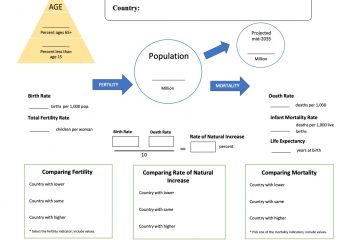
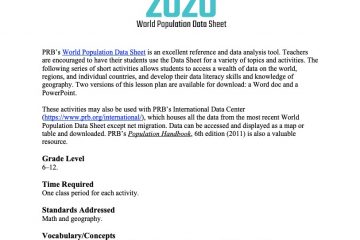



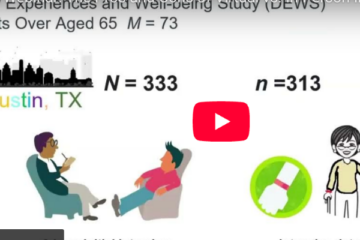



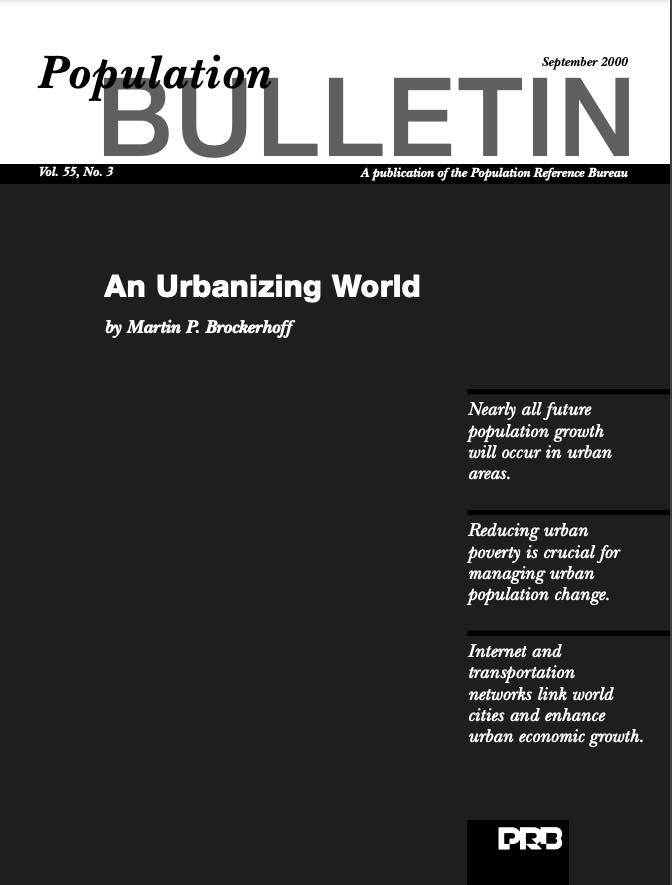 ">
">